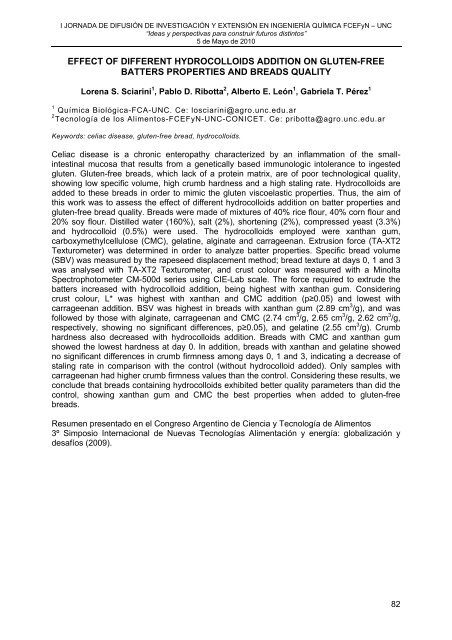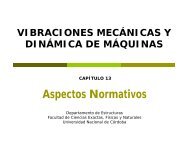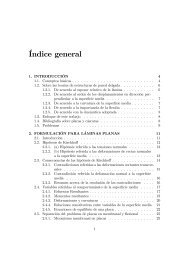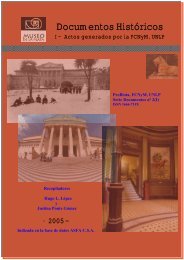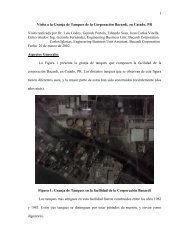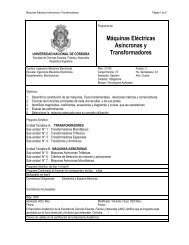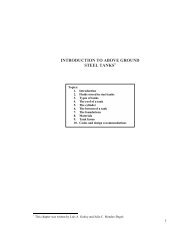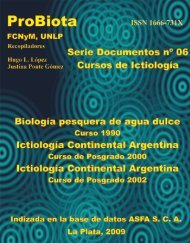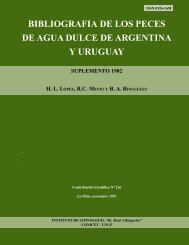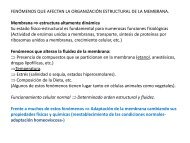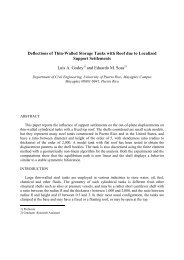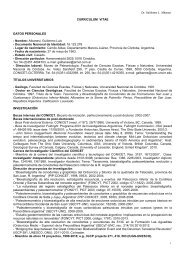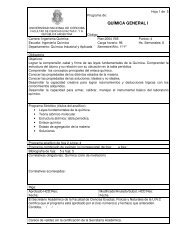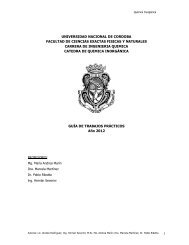Libro de resúmenes - Facultad de Ciencias Exactas, FÃsicas y ...
Libro de resúmenes - Facultad de Ciencias Exactas, FÃsicas y ...
Libro de resúmenes - Facultad de Ciencias Exactas, FÃsicas y ...
- No tags were found...
Create successful ePaper yourself
Turn your PDF publications into a flip-book with our unique Google optimized e-Paper software.
I JORNADA DE DIFUSIÓN DE INVESTIGACIÓN Y EXTENSIÓN EN INGENIERÍA QUÍMICA FCEFyN – UNC“I<strong>de</strong>as y perspectivas para construir futuros distintos”5 <strong>de</strong> Mayo <strong>de</strong> 2010EFFECT OF DIFFERENT HYDROCOLLOIDS ADDITION ON GLUTEN-FREEBATTERS PROPERTIES AND BREADS QUALITYLorena S. Sciarini 1 , Pablo D. Ribotta 2 , Alberto E. León 1 , Gabriela T. Pérez 11 Química Biológica-FCA-UNC. Ce: losciarini@agro.unc.edu.ar2 Tecnología <strong>de</strong> los Alimentos-FCEFyN-UNC-CONICET. Ce: pribotta@agro.unc.edu.arKeywords: celiac disease, gluten-free bread, hydrocolloids.Celiac disease is a chronic enteropathy characterized by an inflammation of the smallintestinalmucosa that results from a genetically based immunologic intolerance to ingestedgluten. Gluten-free breads, which lack of a protein matrix, are of poor technological quality,showing low specific volume, high crumb hardness and a high staling rate. Hydrocolloids aread<strong>de</strong>d to these breads in or<strong>de</strong>r to mimic the gluten viscoelastic properties. Thus, the aim ofthis work was to assess the effect of different hydrocolloids addition on batter properties andgluten-free bread quality. Breads were ma<strong>de</strong> of mixtures of 40% rice flour, 40% corn flour and20% soy flour. Distilled water (160%), salt (2%), shortening (2%), compressed yeast (3.3%)and hydrocolloid (0.5%) were used. The hydrocolloids employed were xanthan gum,carboxymethylcellulose (CMC), gelatine, alginate and carrageenan. Extrusion force (TA-XT2Texturometer) was <strong>de</strong>termined in or<strong>de</strong>r to analyze batter properties. Specific bread volume(SBV) was measured by the rapeseed displacement method; bread texture at days 0, 1 and 3was analysed with TA-XT2 Texturometer, and crust colour was measured with a MinoltaSpectrophotometer CM-500d series using CIE-Lab scale. The force required to extru<strong>de</strong> thebatters increased with hydrocolloid addition, being highest with xanthan gum. Consi<strong>de</strong>ringcrust colour, L* was highest with xanthan and CMC addition (p≥0.05) and lowest withcarrageenan addition. BSV was highest in breads with xanthan gum (2.89 cm 3 /g), and wasfollowed by those with alginate, carrageenan and CMC (2.74 cm 3 /g, 2.65 cm 3 /g, 2.62 cm 3 /g,respectively, showing no significant differences, p≥0.05), and gelatine (2.55 cm 3 /g). Crumbhardness also <strong>de</strong>creased with hydrocolloids addition. Breads with CMC and xanthan gumshowed the lowest hardness at day 0. In addition, breads with xanthan and gelatine showedno significant differences in crumb firmness among days 0, 1 and 3, indicating a <strong>de</strong>crease ofstaling rate in comparison with the control (without hydrocolloid ad<strong>de</strong>d). Only samples withcarrageenan had higher crumb firmness values than the control. Consi<strong>de</strong>ring these results, weconclu<strong>de</strong> that breads containing hydrocolloids exhibited better quality parameters than did thecontrol, showing xanthan gum and CMC the best properties when ad<strong>de</strong>d to gluten-freebreads.Resumen presentado en el Congreso Argentino <strong>de</strong> Ciencia y Tecnología <strong>de</strong> Alimentos3º Simposio Internacional <strong>de</strong> Nuevas Tecnologías Alimentación y energía: globalización y<strong>de</strong>safíos (2009).82


